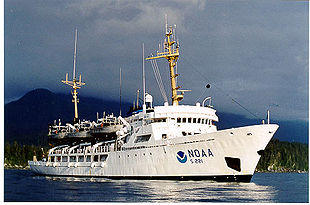NOAAS Rainier
 NOAAS Rainier (S 221)
| |
| History | |
|---|---|
| Name | USC&GS Rainier (MSS 21) |
| Namesake | Mount Rainier in Washington |
| Builder | Aerojet-General Shipyards, Jacksonville, Florida |
| Launched | March 1967 |
| Acquired | April 1968 (delivered) |
| Commissioned | 2 October 1968 |
| Fate | Transferred to National Oceanic and Atmospheric Administration 3 October 1970 |
| Name | NOAAS Rainier (S 221) |
| Namesake | Previous name retained |
| Acquired | Transferred from U.S. Coast and Geodetic Survey 3 October 1970 |
| Homeport | Newport, Oregon |
| Status | Active |
| General characteristics | |
| Class and type | Fairweather-class hydrographic survey ship |
| Tonnage |
|
| Displacement | 1,800 tons |
| Length | 70.4 m (231 ft) |
| Beam | 12.8 m (42 ft) moulded |
| Draft | 5.18 m (17.0 ft) maximum |
| Installed power | 2,400 shp (1.8 MW) |
| Propulsion | Two 1,200 hp (0.89 MW) General Motors geared diesel engines, 2 shafts, 107,000 US gallons (410,000 L) fuel; one 200 hp (0.15 MW) Detroit Diesel/Bird Johnson geared through-hull bow thruster |
| Speed | 12 to 13 knots (22 to 24 km/h) (cruising) |
| Range | 5,898 nautical miles (10,923 km) |
| Endurance | 22 days |
| Boats & landing craft carried | Five survey launches, two small open boats, one fast rescue boat. |
| Complement | 49 (10 NOAA Corps officers, 4 licensed engineers, and 35 other crew members), plus up to 4 scientists[1] |
| Notes | Ice-strengthened hull; 300 kilowatts electrical power plus 75-kilowatt emergency generator |
NOAA Ship Rainier (S 221) is an American survey vessel in commission with the National Oceanic and Atmospheric Administration (NOAA) since 1970. Prior to her NOAA service, she was in commission in the United States Coast and Geodetic Survey as USC&GS Rainier (MSS 21) from 1968 to 1970. She is named for Mount Rainier in the state of Washington and is the sister ship of NOAAS Fairweather (S 220) and the decommissioned NOAAS Mount Mitchell (S 222).
Construction and commissioning
Rainier was built as a "medium survey ship" (MSS) for the U.S. Coast and Geodetic Survey at the Aerojet-General Shipyards in Jacksonville, Florida. She was launched in March 1967, delivered to the Coast and Geodetic Survey in April 1968, and commissioned on 2 October 1968 as USC&GS Rainier (MSS 21) in a joint ceremony with her sister ship USC&GS Fairweather (MSS 20) at the Pacific Marine Center in Seattle, Washington.[2] When NOAA was formed on 3 October 1970 and took over the Coast and Geodetic Survey's assets, she became a part of the NOAA fleet as NOAAS Rainier (S 221).

Rainier's ice-hardened hull is 231 feet (70 m) long. She has 79 bunk spaces. Capacity for 59 people to eat at time can be found in the three mess rooms and officer's wardroom. She carries a complement of 53, consisting of 10 NOAA Corps officers, four licensed engineers, and 39 other crew members, and seven of the crew are certified NOAA divers. In addition to her crew, she can accommodate up to four scientists.
The deck equipment features a large crane aft and two bow-mounted fixed cranes. This equipment gives Rainier a lifting capacity of up to 5,000 pounds (2,268 kg). She originally had an A-frame aft, but it was removed during a major refit in 2009-2010 in favor of a Rolls-Royce Moving Vessel Profiler for underway sound velocity determination during mapping missions.
Rainier has one laboratory of 240 square feet (22 m2) to support oceanographic observations and diving operations. The ship has an intermediate-depth Kongsberg EM710 multibeam survey system. She carries four Jensen aluminum survey launches equipped with RESON shallow multibeam systems. She has a fast survey boat for near-shore operations that uses waterjet propulsion, a general support boat, and a Fast Rescue Boat.
The scientific equipment aboard Rainier includes five conductivity, temperature, depth (CTD) sensors and sediment sampling equipment, and she has the capability to tow a sidescan sonar unit or mount one in a fixed position.
NOAA describes Rainier as "the most productive hydrographic platform in the world."[3]
Notes
- ^ Per Combat Fleets of the World 2007, the complement is 69 (12 NOAA Corps officers, 5 licensed civilian officers and 52 other crew members) plus up to 4 scientists.
- ^ Invitation to joint commissioning ceremony of ESSA Ships FAIRWEATHER and RAINIER on October 2, 1968
- ^ NOAA Marine Operations (at http://www.moc.noaa.gov/ra/index.html).
External links
- "NOAA Ship RAINIER". May 5, 2004. Retrieved May 9, 2006.
